Related Research Articles
The elegiac couplet or elegaic distich is a poetic form used by Greek lyric poets for a variety of themes usually of smaller scale than the epic. Roman poets, particularly Catullus, Propertius, Tibullus, and Ovid, adopted the same form in Latin many years later. As with the English heroic couplet, each pair of lines usually makes sense on its own, while forming part of a larger work.
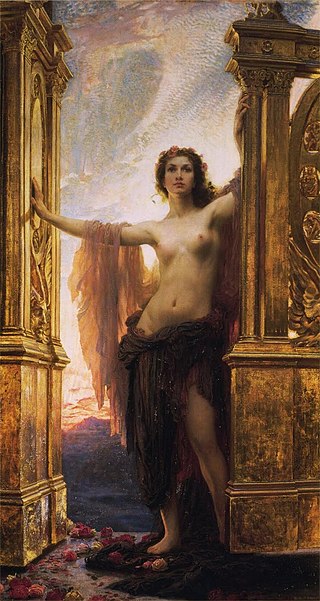
In ancient Greek mythology and religion, Eos is the goddess and personification of the dawn, who rose each morning from her home at the edge of the river Oceanus to deliver light and disperse the night. In Greek tradition and poetry, she is characterized as a goddess with a great sexual appetite, who took numerous human lovers for her own satisfaction and bore them several children. Like her Roman counterpart Aurora and Rigvedic Ushas, Eos continues the name of an earlier Indo-European dawn goddess, Hausos. Eos, or her earlier Proto-Indo-European (PIE) ancestor, also shares several elements with the love goddess Aphrodite, perhaps signifying Eos's influence on her or otherwise a common origin for the two goddesses. In surviving tradition, Aphrodite is the culprit behind Eos' numerous love affairs, having cursed the goddess with insatiable lust for mortal men.
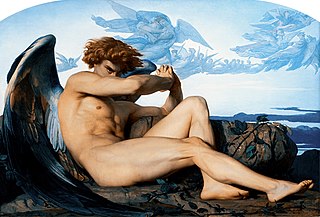
The most common meaning for Lucifer in English is as a name for the Devil in Christian theology. He appeared in the King James Version of the Bible in Isaiah and before that in the Vulgate, not as the name of a devil but as the Latin word lucifer (uncapitalized), meaning "the morning star", "the planet Venus", or, as an adjective, "light-bringing". It is a translation of the Hebrew word הֵילֵל, hêlēl, meaning "Shining One".

"Dies irae" is a Latin sequence attributed to either Thomas of Celano of the Franciscans (1200–1265) or to Latino Malabranca Orsini, lector at the Dominican studium at Santa Sabina, the forerunner of the Pontifical University of Saint Thomas Aquinas in Rome. The sequence dates from the 13th century at the latest, though it is possible that it is much older, with some sources ascribing its origin to St. Gregory the Great, Bernard of Clairvaux (1090–1153), or Bonaventure (1221–1274).

De rerum natura is a first-century BC didactic poem by the Roman poet and philosopher Lucretius with the goal of explaining Epicurean philosophy to a Roman audience. The poem, written in some 7,400 dactylic hexameters, is divided into six untitled books, and explores Epicurean physics through poetic language and metaphors. Namely, Lucretius explores the principles of atomism; the nature of the mind and soul; explanations of sensation and thought; the development of the world and its phenomena; and explains a variety of celestial and terrestrial phenomena. The universe described in the poem operates according to these physical principles, guided by fortuna ("chance"), and not the divine intervention of the traditional Roman deities.

Aurvandill is a figure in Germanic mythology. In Norse mythology, the god Thor tosses Aurvandill's toe – which had frozen while the thunder god was carrying him in a basket across the Élivágar rivers – into the sky to form a star called Aurvandils-tá. In wider medieval Germanic-speaking cultures, he was known as Ēarendel in Old English, Aurendil in Old High German, Auriwandalo in Lombardic, and possibly as 𐌰𐌿𐌶𐌰𐌽𐌳𐌹𐌻 (auzandil) in Gothic. An Old Danish Latinized version, Horwendillus (Ørvendil), is also the name given to the father of Amlethus (Amleth) in Saxo Grammaticus' Gesta Danorum.
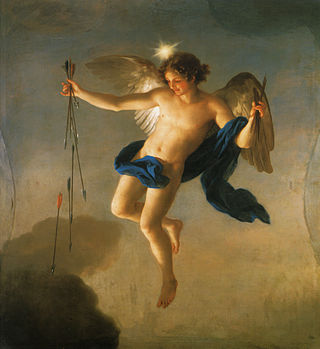
In Greek mythology, Hesperus is the Evening Star, the planet Venus in the evening. A son of the dawn goddess Eos, he is the half-brother of her other son, Phosphorus. Hesperus' Roman equivalent is Vesper. By one account, Hesperus' father was Cephalus, a mortal, while Phosphorus was the star god Astraeus. Other sources, however, state that Hesperus was the brother of Atlas, and thus the son of Iapetus.

Phosphorus is the god of the planet Venus in its appearance as the Morning Star. Another Greek name for the Morning Star is "Eosphorus", which means "dawn-bringer". The term "eosphorus" is sometimes met in English. As an adjective, the word "phosphorus" is applied in the sense of "light-bringing" and "torch-bearing" as an epithet of several gods and goddesses, especially of Hecate but also of Artemis/Diana and Hephaestus. Seasonally, Venus is the "light bringer" in the northern hemisphere, appearing most brightly in December, signalling the "rebirth" of longer days as winter wanes.

Luciferianism is a belief system that venerates the essential characteristics that are affixed to Lucifer, the name of various mythological and religious figures associated with the planet Venus. The tradition usually reveres Lucifer not as the Devil, but as a destroyer, a guardian, liberator, light bringer or guiding spirit to darkness, or even the true god. According to Ethan Doyle White of the Britannica, among those who "called themselves Satanists or Luciferians", some insist that Lucifer is an entity separate from Satan, while others maintain "the two names as synonyms for the same being".

*H₂éwsōs or *Haéusōs is the reconstructed Proto-Indo-European name of the dawn goddess in the Proto-Indo-European mythology.
Iambic tetrameter is a poetic meter in ancient Greek and Latin poetry; as the name of a rhythm, iambic tetrameter consists of four metra, each metron being of the form | x – u – |, consisting of a spondee and an iamb, or two iambs. There usually is a break in the centre of the line, thus the whole line is:
| x – u – | x – u – || x – u – || x – u – |
The Ambrosian hymns are a collection of early hymns of the Latin liturgical rites, whose core of four hymns were by Ambrose of Milan in the 4th century.

The War in Heaven is a mythical conflict between supernatural forces in traditional Christian cosmology, attested in the Book of Revelation alongside proposed parallels in the Hebrew Bible and the Dead Sea Scrolls. It is described as the result of the Archangel Satan rebelling against God and leading to a war between his followers and those still loyal to God, led by the Archangel Michael. Within the New Testament, the War in Heaven provides basis for the concept of the fallen angels and for Satan's banishment to Hell. The War is frequently featured in works of Christian art, such as John Milton's epic poem Paradise Lost, which describes it as occurring over the course of three days as a result of God the Father announcing Jesus Christ as His Son.
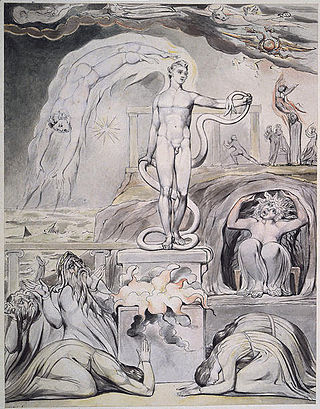
On the Morning of Christ's Nativity is a nativity ode written by John Milton in 1629 and published in his Poems of Mr. John Milton (1645). The poem describes Christ's Incarnation and his overthrow of earthly and pagan powers. The poem also connects the Incarnation with Christ's Crucifixion.
Latin prosody is the study of Latin poetry and its laws of meter. The following article provides an overview of those laws as practised by Latin poets in the late Roman Republic and early Roman Empire, with verses by Catullus, Horace, Virgil and Ovid as models. Except for the early Saturnian poetry, which may have been accentual, Latin poets borrowed all their verse forms from the Greeks, despite significant differences between the two languages.
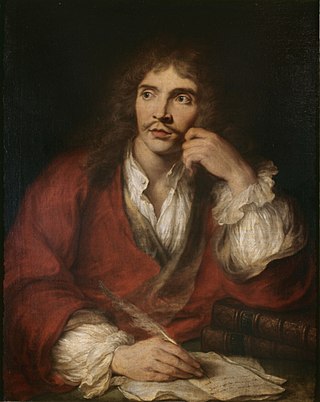
The French alexandrine is a syllabic poetic metre of 12 syllables with a medial caesura dividing the line into two hemistichs (half-lines) of six syllables each. It was the dominant long line of French poetry from the 17th through the 19th century, and influenced many other European literatures which developed alexandrines of their own.
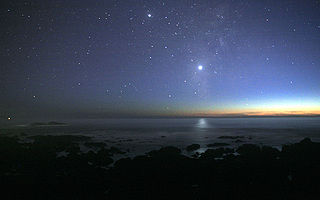
Venus, as one of the brightest objects in the sky, has been known since prehistoric times and has been a major fixture in human culture for as long as records have existed. As such, it has a prominent position in human culture, religion, and myth. It has been made sacred to gods of many cultures, and has been a prime inspiration for writers and poets as the morning star and evening star.

The Murbach hymns are a collection of 27 early medieval Latin hymns with interlinear Old High German translation. The hymns are intended to be sung at certain times of the day in the course of the year, being introduced with the header Incipiunt hymni canendi per circulum anni.

Points and Dances from the Opera "Taverner" or Points and Dances from "Taverner", Op. 46, is a suite for ensemble written by British composer Peter Maxwell Davies from his own opera Taverner. Subtitled "instrumental dances and keyboard pieces from the opera for instrumental ensemble", it was finished in 1970.
References
- ↑ John McGuckin At the Lighting of the Lamps: Hymns of the Ancient Church Carmen Aurorae - A Hymn at Dawn pp.32-33
- ↑ Latin from the Liturgia Horarum, and Latin Hymns, F. A. March, 1894. Translation by W J. Copeland (1804-1885).
- ↑ Charles Kraszewski Rossetti’s Armadillo 2014 -Now, “Aeterne rerum Conditor” is not merely a hymn of thanksgiving for the return of safety implicit in the gift of the renewing light. It is also a hymn of praise to the Creator, an expression of awe at the beauty of the world that surrounds us, p.50 "The didactic core of “Aeterne rerum Conditor” is not the creative power of God, but rather His inexhaustible capacity for love and forgiveness. In the most recognizable Gallic allusion in the poem, lines 15-16, St. Ambrose has the rooster's crow remind the reader of Peter's breakdown in Caiaphas' courtyard." p.51